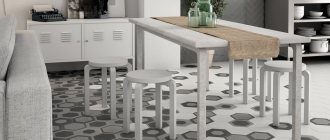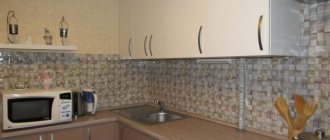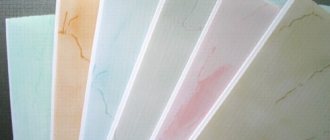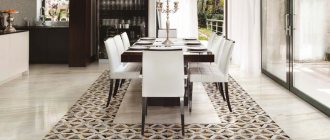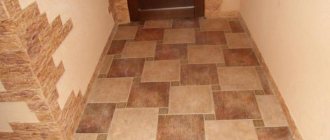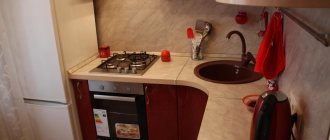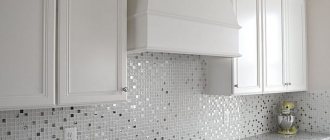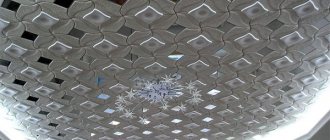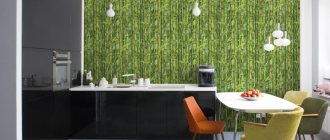An apron in the kitchen is an integral part of the interior. Regardless of the size of the room, an apron can become a bright accent with a minimal investment of money. The most successful solution is to use materials such as tiles and glass. But in order to appreciate all the advantages of ceramic tiles, let’s consider the advantages and disadvantages of all types of materials that can be used for a backsplash.
Please note that for the harmony of space it is necessary to respect the proportions of the kitchen itself and the density of the objects located in it. That is, the smaller the size of the kitchen, the more kitchen items, and the more minimalist the apron should look.
Pros and cons of kitchen tiles
The main advantages of tiles as a finishing material for the kitchen are:
- this material is durable in use;
- high strength;
- presented on the sales market in a wide range of designs and colors;
- tolerates high humidity and temperature changes well;
- heat resistance;
- It does not require special care.
One of the disadvantages is that when you decide to cover the kitchen floor with tiles, you end up with a slippery surface.
Advantages and disadvantages
The main advantages of tiles as a finishing material for the kitchen:
- High strength, durability;
- Resistance to high moisture, temperature, fire, mold;
- Large selection of colors, sizes, textures and designs;
- Safety, which is achieved by firing the clay contained in the composition during manufacture. High temperature kills all harmful substances;
- The ability to hide defects and unevenness on the walls;
- Easy to wash and remove dirt.
Kitchen fully tiled
Flaws:
- When finishing the floor, the surface becomes slippery;
- To install in difficult places, the material will have to be cut;
- When working with a plot drawing, difficulties may arise, since you need to follow the sequence of installation;
- Wall decoration requires a lot of consumables.
Ceramic tiles for the kitchen
Ceramic kitchen tiles are the most popular and quite affordable in cost. Ceramic tiles are divided into 3 categories:
- glossy;
- matte;
- with spraying.
As a rule, this type of tile consists of sand, clay and various minerals, which are fired and then covered with a special glaze.
Ceramic tiles can be combined with other types to create a unique and original coating. Kitchen design with ceramic tiles can be made to suit any style.
Porcelain tiles in the kitchen
Porcelain tiles are considered one of the stronger and more durable materials for flooring in the kitchen.
This material can withstand heavy weight well and also does not absorb water, which is very important for a kitchen floor. Porcelain tiles resemble stone in appearance, and this design of kitchen floor tiles is considered an excellent option.
Using decorative tiles in the interior
It doesn’t matter what type of decorative tile will be chosen for decoration. In any case, the tile will add originality and unusualness to the interior. This material is highly durable, practical and moisture resistant, which is extremely important in the kitchen, especially in the work area. The tiles also boast a high level of aesthetics, which means they will delight household members and house guests for a long time.
When decorating a kitchen with tiles, you can not limit yourself only to work areas, because ceramics are also great for cladding walls and ceilings
Glass tiles for kitchen
Glass tiles are usually used in the kitchen to create a backsplash or to cover walls. This type of tile is divided into categories:
Note!
Epoxy grout for tiles: pros and cons, scope, varieties, how to work with it (instructions + photos)
Do-it-yourself tile shower tray step by step: instructions, dimensions, design, installation of communications, types of structures, photos
White tiles in the bathroom: 170 photos of the best ideas and new tile designs. Layout schemes and beautiful combinations
- glossy;
- matte;
- transparent;
- colored tiles.
Glass tiles look very aesthetically pleasing in the kitchen and do not require special care; the only thing is that they must be periodically treated with a special glass cleaner.
Stone tiles for kitchen
As a rule, natural stone tiles are used to create a backsplash or decorate one wall in the kitchen.
You should not use it in a small kitchen, since this type of tile is quite textured and visually reduces the area.
Ideas for decorating an apron (selection of photos)
A selection of photos and recommendations on what tiles should be on the kitchen work wall will help you make the right choice.
Tips for choosing tiles
Buying tiles for the kitchen is one of the important points; when choosing, you need to take into account a lot of nuances:
- The design of the tiles for the kitchen wall should be combined with the color scheme of the kitchen unit.
- When buying tiles, you should take them with a reserve, about 10-15% more than according to calculations.
- For the kitchen, the ideal tile option with the manufacturer's mark is AA.
- The kitchen floor tile design should be porous, otherwise it will get dirty too quickly.
- When choosing tiles for the floor, you should pay attention to the coefficient of friction, it is better that it be from 0.5 to 0.8.
- If you want to use tiles of different colors, do not overdo it, just choose 2-3 tones.
- The size of the tiles should be proportional to the total area; you should not choose large tiles for a small kitchen.
- If kitchen tiles will be combined with plain wallpaper, then it is better to choose tiles of a contrasting color or with a pattern.
Design options
Pastel colors
Minimalism in the kitchen: laconic facades without handles, glossy surfaces, wood texture, stone countertops, creamy beige interior colors.
Kitchen with wood-effect facades
Neoclassicism in monochrome shades.
Beige straight kitchen with neoclassical facades
Mint walls, stone floor texture and creamy furniture. Tall furniture does not look bulky due to the light shade.
Green apron in a white kitchen
LED lighting reveals the relief of ceramic bricks, revealing the volume of the masonry.
Green kitchen and white apron
Diagonal layout combined with decorative panels. The finish imitates aged stone. This combination suits the classic style.
Diagonal layout and ceramic panels in the kitchen
Rich colors
Blue accent in a black and white kitchen interior.
Blue apron in a white kitchen
Green mosaic in the kitchen
A terracotta tiled screen protects the walls from moisture in the washing area.
Terracotta tiles in the kitchen
Black accent against the background of a light interior.
Black tiles in a white kitchen
Bright collections
Fruit inserts harmonize with the background tone and bright stripes of tiles. Most manufacturers have similar collections. The decor can be dispersed along the entire length, or concentrated in one part.
Bright tiles on the backsplash
Sometimes the decor is chosen from another collection. The main thing is that the thickness of adjacent parts matches - in this case the surface will look uniform.
Lime apron in a white kitchen
Patchwork ornament should be used with caution. A mottled pattern can cause irritation if the cladding occupies a large area. In this interior, patchwork decorates the walls and the insert on the floor; other parts of the decoration and kitchen furniture are kept in simple colors. In such a room there is no feeling of fatigue from the abundance of color.
Patchwork in the kitchen with black stone countertop
Mixing different formats and colors. The complex design looks harmonious due to the use of two main shades.
Blue-green tiles in the kitchen
Mosaic backsplash with bright segments. The walls and floor support the tone of the mosaic.
Orange and yellow mosaic
Decorative inserts
As a rule, decor is more expensive than background material. Despite the cost, this solution definitely makes sense. Decorative details adorn the apron, diluting the monotonous color.
Beige apron with decor
Uneven contours, imitation of aged clay tiles or stone are suitable for a set in country and Provence style.
White solid wood kitchen and beige ceramic apron
Decor that illustrates nature. The sepia tone of the images follows the tone of the facades.
Marble countertop in the kitchen
Mosaic panels are suitable for any kitchen style. The most important thing is to choose the right pattern and color scheme.
Mosaic with mirror inserts
Decorative inserts with floral patterns are often found in classic collections of ceramics, Provence and country. The design is applied to one tile or to several elements (4-6 pieces).
Sunflowers on the apron
Common decor dimensions: 500x300, 600x400, 600x600, 800x600 mm. Photo tiles with abstraction, city landscapes and stylized culinary images are suitable for modern interiors.
Materials
Ceramic
Gray and white facades in the kitchen
Glass
Red glass apron
Mirror. Such material will visually increase the area, but the constant reflection of objects can create discomfort in everyday life.
Mirror mosaic in the kitchen
Metal. Metallized Ferrum Style series. Manufacturer: STS-Trading company. These tiles are used to cover floors, walls, facades, stairs, columns, building bases, and fireplaces.
Metal tiles in the kitchen
Kitchen tile color scheme
Depending on the style and overall design of the kitchen, it is necessary to select the color scheme of the tiles. You can use absolutely any color and tone, the main thing is that it matches the interior and is not too catchy to the eye. Also, the color of the tile is chosen depending on what exactly it will be used for: as the main material for wall decoration or for an apron or floor covering.
Note!
Italian tiles for floors and walls: photos of beautiful tile designs in the bathroom and kitchen. Choosing tile color, style and size
Marble tiles for the bathroom: TOP-200 photos of original design, ideas for mixing and matching
Do-it-yourself tile shower step by step: instructions, algorithm of actions, dimensions, layout diagrams, photo of a shower with and without a tray
The delicate colors of the tiles match almost all color and style solutions of the kitchen. In cases where the kitchen set is black and white, you can make a bright apron as an accent. Also, an apron in a contrasting color goes well with a light-colored set.
Tiles with imitation marble chips are well suited for large kitchens; they add additional luxury and elegance.
A kitchen design with white tiles of any kind gives a cozy and spacious feel, and also fits well with a variety of styles. White tiles can be used as any coating, with both a matte and glossy effect. If you use black grout to decorate the walls with white tiles, you can emphasize the geometry of the kitchen and add additional structure.
Depending on the style of the kitchen, you can use tiles in green, lilac, gray, brown, blue and other tones.
Types of stone
A common feature for all types of decorative stone is uniqueness. Each coating is unique. The material used in finishing work can be of natural or artificial origin.
Natural
This view is created by nature. The role of a person in preparing it for finishing use comes down to mining, sorting and giving the stone the required shape. This material is believed to have vital energy and even improve health. In cold weather it creates comfort and retains accumulated heat for a long time, and in hot weather it provides coolness. The durability of natural stone is estimated at many decades .
A highlight that will add variety to the interior
Granite is used to decorate the kitchen, bringing sparkles and shimmer . Marble brings rigor and nobility to the interior. Travertine fills the kitchen with light and promotes a good mood. River pebbles bring coolness and distract from problems. Slate creates a homely effect and resembles a hearth, while sandstone and limestone provide warmth.
When choosing natural decorative stone for kitchen decoration, you need to prepare for serious costs.
Artificial
The finishing material belonging to this group is only partly artificial, since the lion's share in its composition is occupied by the same natural material, represented by crumbs and sand.
In terms of characteristics, artificial decorative stone is not much different from its natural counterpart. Additives that act as a gluing material do not impair environmental performance, and in some cases make it possible to achieve greater strength and wear resistance from the material. It is lightweight and outperforms natural ones in terms of economy.
Will add comfort to the interior
Tiles with drawings and patterns
One of the most popular ways to give your kitchen an original look is to create a modern backsplash design using tiles with ornaments or unusual patterns.
The only thing is that you should not use tiles with a significant number of tones. Also, the tile pattern should be intertwined with the interior of the kitchen, consistent with its style and design. Tiles with designs and patterns are best used as an accent or highlighting a certain area.
Note!
- Mosaic from broken tiles: step-by-step instructions on how to lay it out with your own hands (140 photo ideas)
Mosaic for the bathroom: TOP-150 photos of new designs, as well as modern ideas for combining mosaic tiles
Do-it-yourself water heated floor under tiles step by step: installation instructions with photos and descriptions, installation and connection
Advantages of tiles
Ceramic tiles have technical characteristics that distinguish them favorably from other interior materials.
The main ones:
- Strength, thermal resistance;
- Resistance to aggressive cleaning materials;
- Safety in operation;
- Durability.
A significant advantage is the wide selection of tiles. For interior decoration, you can choose glossy or matte tiles of any color (plain, combined, with a pattern), various sizes, as well as imitation of other materials (wood, glass, stone, mosaic).
Trend 2022 - kitchen tiles
Among the 2022 tile designs for the kitchen are:
- tiles with imitation brickwork in a matte or glazed finish. This tile is well suited for kitchens in Provence, loft, and minimalist styles;
- wood-look ceramic tiles. This tile is an excellent option for decorating a kitchen in an eco-style; it can be used both for flooring and for wall decoration;
- photo tiles are best used to create a backsplash or as an accent;
- tiles with metal imitation. These tiles are an ideal solution for a kitchen in a high-tech or minimalist style. It is worth noting that stains, drops of water, and splashes of grease are very noticeable on it;
- tiles with floral and plant patterns. This tile design suits many kitchen styles; it can be used to cover the entire area of walls or floors, or to create an accent or highlight an area.
Mosaic tiles for the kitchen
Mosaic tiles are a special type of tile that is very often used to create a backsplash in the kitchen. This material is very practical, easy to care for and durable to use.
Mosaic tiles are available for sale in a wide range, you can choose them to suit any style and design. This tile is very easy to lay on walls and goes well with other types of tiles.
Mosaic tiles can also be used to create an accent or highlight a certain area. Tiles of this format are not used as flooring.
Apron design - basic recommendations
When choosing tiles for decorating a backsplash, you need to pay attention to a number of criteria.
- Tile type. Of course, there is not as much pressure on the backsplash as there is on the flooring. However, this area must be very resistant to heat and cleaning agents. The best option would be class PEI I and PEI II.
- Size. The edges of the apron should coincide with the furniture boundaries. The difficulty lies in the fact that the tiles are laid before the set is installed. If it is made according to standard dimensions, then you can focus on a tabletop with a height of 85 cm from the floor, while the standard height of the apron is 60 cm. Small square tiles (15*15) are considered the most convenient.
- Surface. It can be absolutely anything: glossy, matte, embossed. Each option has its pros and cons: Glossy cladding looks beautiful and creates a feeling of cleanliness with regular proper care. But you need to be prepared for the fact that any drop is visible on such a surface. On a matte surface, drops and splashes are not so noticeable, but over time, the porous surface becomes clogged with dust and drops of grease, and therefore requires more thorough cleaning. The embossed tiled surface looks very impressive, but is not practical as it gets dirty quickly.
- Color. To ensure that the apron is harmonious in the interior, it is better to choose a color similar to that of the furniture or tabletop. The apron can be a contrast to the set, but be combined with the color of the floor or wall decoration.
A bright, cheerful apron in a rustic-style kitchen,
no matter what option you choose when purchasing, it is important to consider that the tiles must correspond to the design idea of the room.
Method of laying tiles
Tiles can be laid in various ways both on the surface of the walls and on the floor.
- In the form of parquet. This principle of laying tiles is most often used for flooring, but it also looks very impressive and stylish on walls. As a rule, tiles with a rectangular narrow shape are used, without any patterns. For a more original and harmonious coating, you can use tiles of several tones.
- Diagonal placement of tiles visually increases space, but only on the floor. If this method is used to place tiles on walls, then you can hide unevenness, but at the same time visually narrow the space.
- Laying tiles in the form of a mosaic is the most popular method. You can use tiles of various sizes and colors.
- Placing tiles “seam to seam” is considered a very bold decision, since this method is very troublesome and requires a significant amount of time. Also, for this method there must be a perfectly flat surface.
- Tiles are often placed on kitchen walls in the form of brickwork. This method looks very stylish and interesting; as a rule, plain tiles are used, without patterns or ornaments.
You can place the tiles in any way you wish, the main thing is not to combine several options into one.

